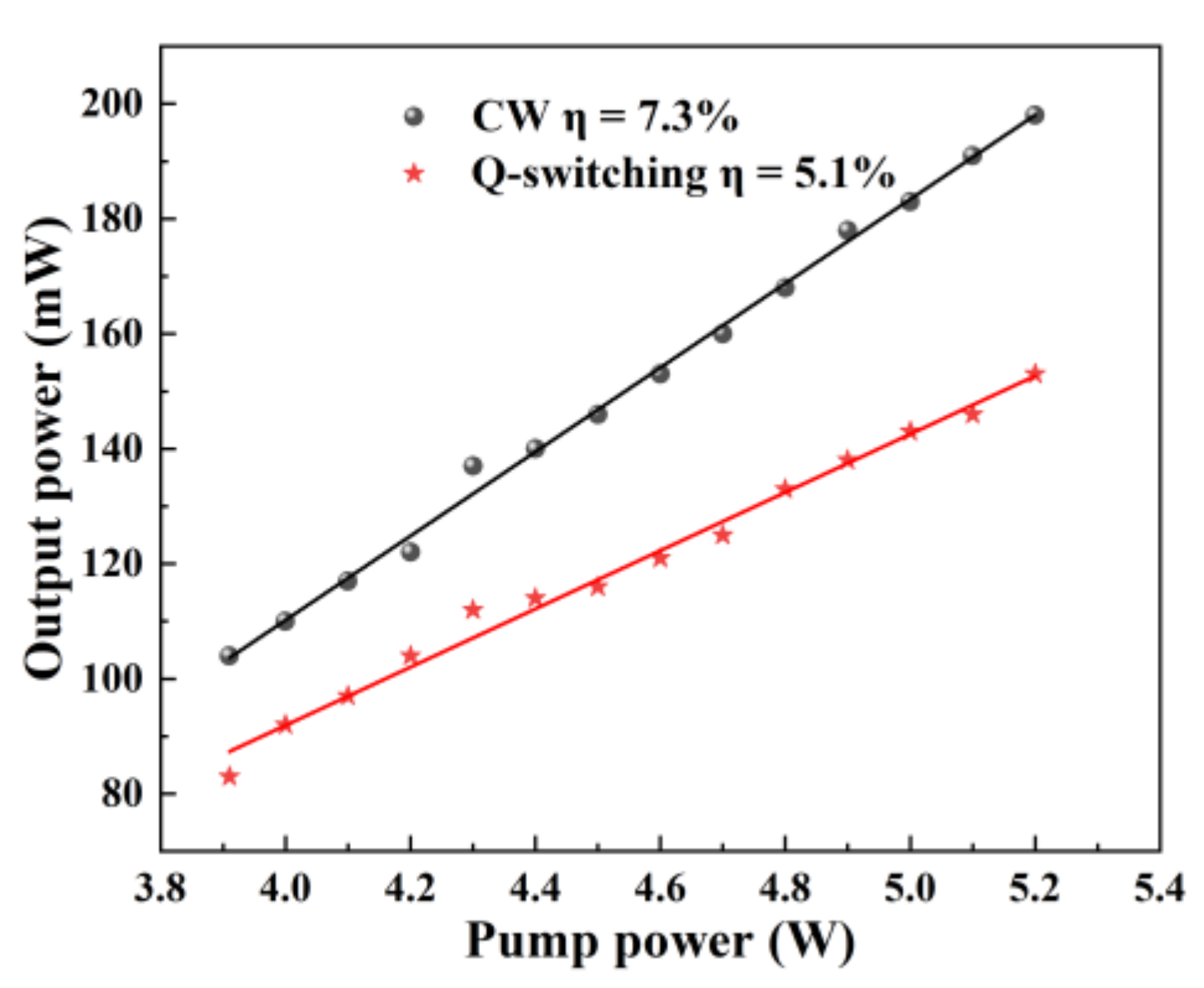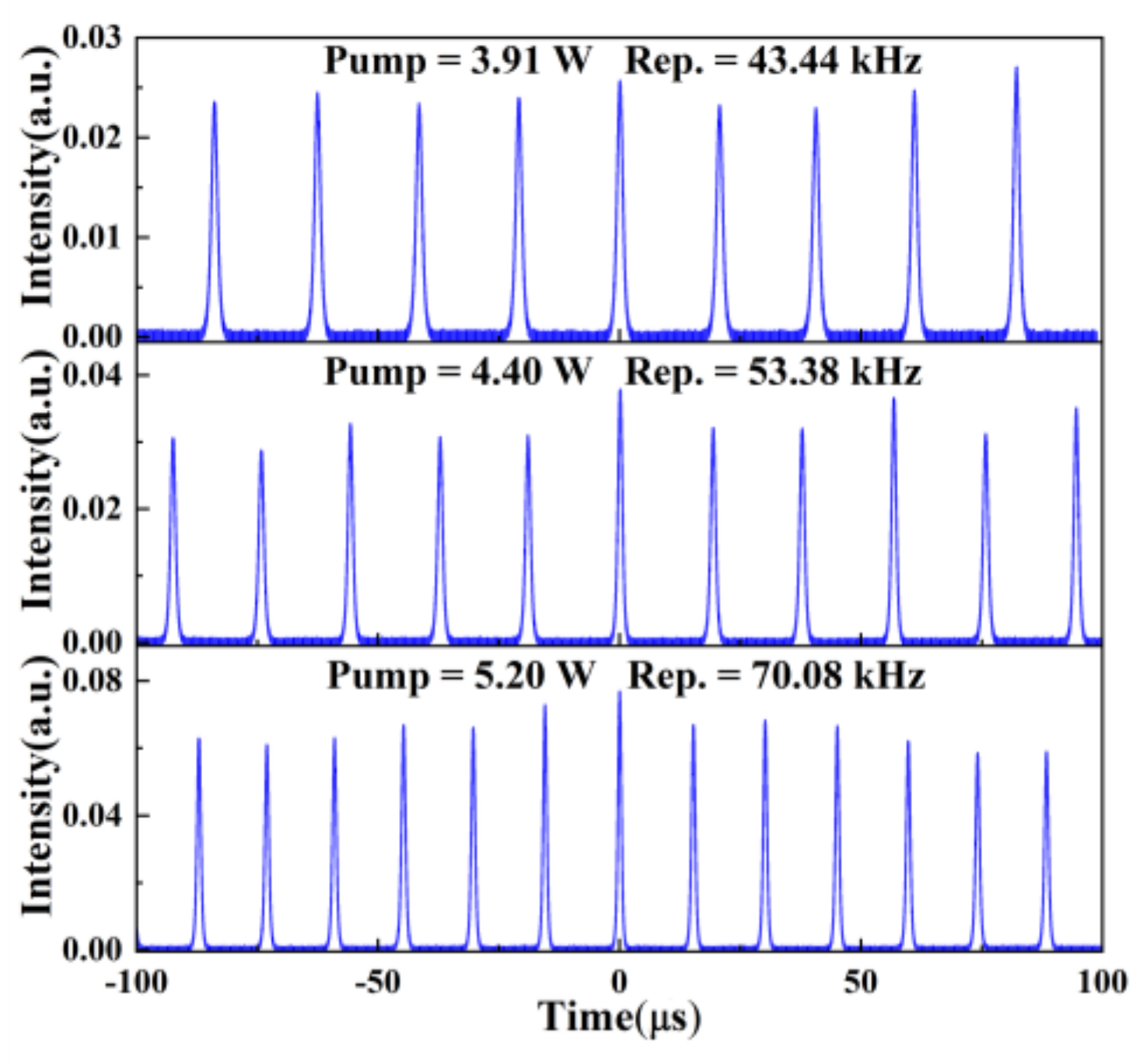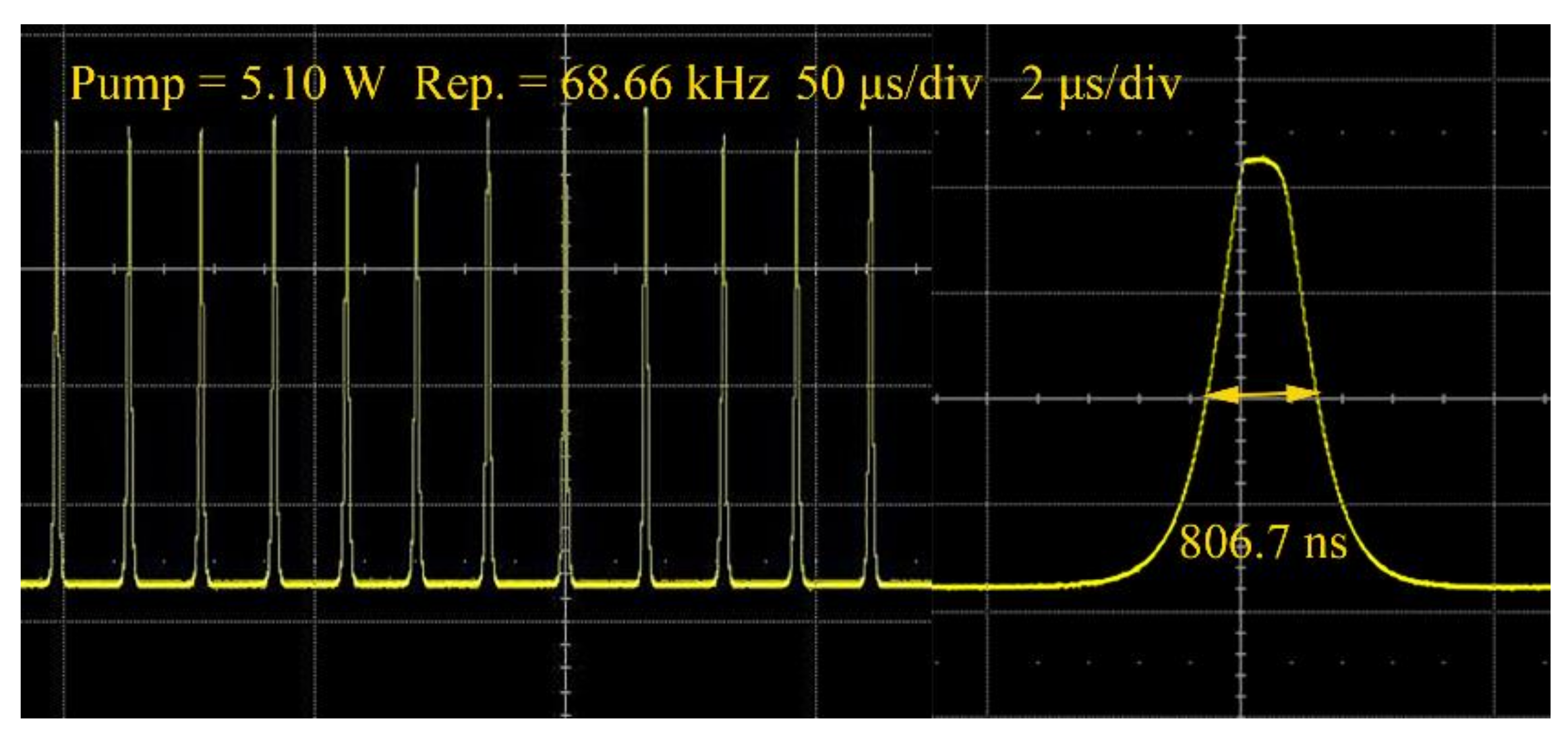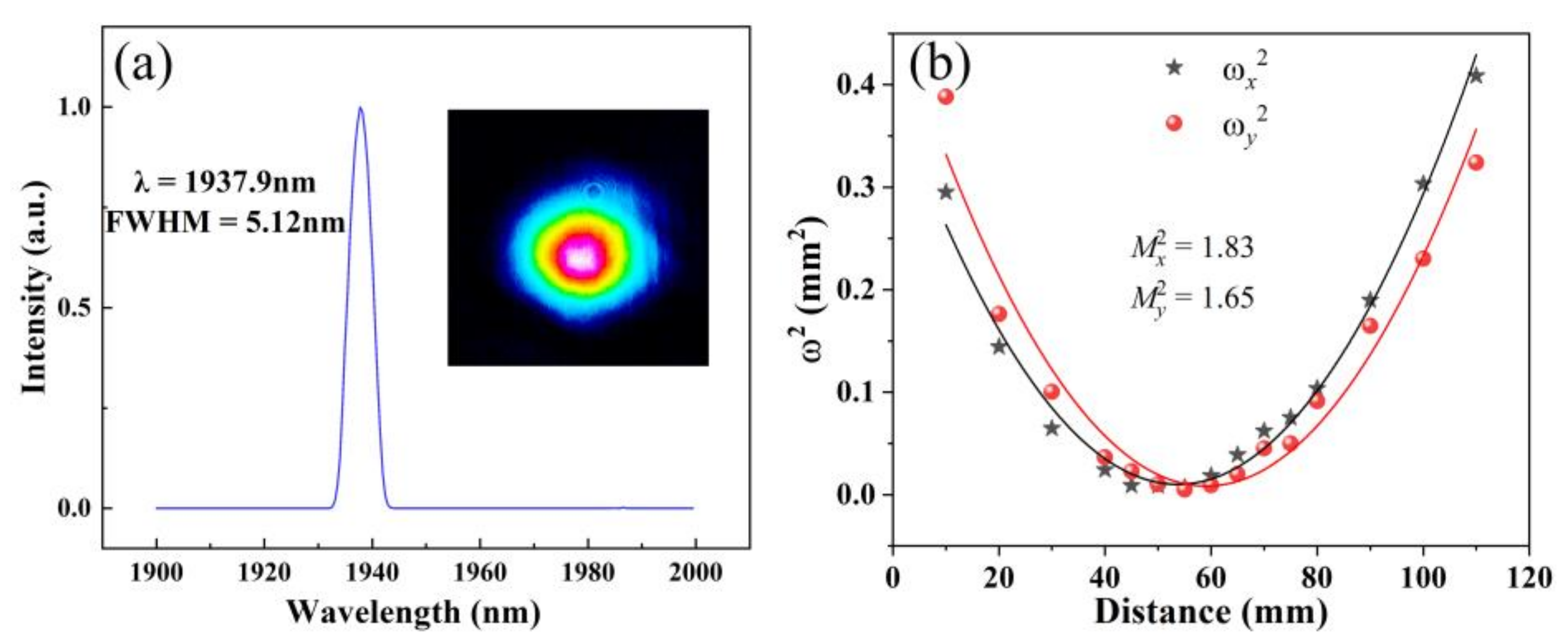Mo:BiVO4 Nanoparticles-Based Optical Modulator and Its Application in a 2-μm Pulsed Laser
Abstract
:1. Introduction
2. Materials and Methods
3. Results
4. Discussion and Conclusions
Author Contributions
Funding
Conflicts of Interest
References
- Keller, U.; Miller, D.A.B.; Boyd, G.D.; Chiu, T.H.; Ferguson, J.F.; Asom, M.T. Solid-state low-loss intracavity saturable absorber for Nd:YLF lasers: An antiresonant semiconductor Fabry-Perot saturable absorber. Opt. Lett. 1992, 17, 505–507. [Google Scholar] [CrossRef]
- Keller, U.; Weingarten, K.J.; Kartner, F.X.; Kopf, D.; Braun, B.; Jung, I.D.; Fluck, R.; Honninger, C.; Matuschek, N.; Aus der Au, J. Semiconductor saturable absorber mirrors (SESAM’s) for femtosecond to nanosecond pulse generation in solid-state lasers. IEEE J. Sel. Top. Quantum Electron. 1996, 2, 435–453. [Google Scholar] [CrossRef] [Green Version]
- Gomes, L.A.; Orsila, L.; Jouhti, T.; Okhotnikov, O.G. Picosecond SESAM-based ytterbium mode-locked fiber lasers. IEEE J. Sel. Top. Quantum Electron. 2004, 10, 129–136. [Google Scholar] [CrossRef]
- Härkönen, A.; Paajaste, J.; Suomalainen, S.; Alanko, J.P.; Grebing, C.; Koskinen, R.; Steinmeyer, G.; Guina, M. Picosecond passively mode-locked GaSb-based semiconductor disk laser operating at 2 μm. Opt. Lett. 2010, 35, 4090–4092. [Google Scholar] [CrossRef] [PubMed]
- Liu, X.; Li, X.; Tang, Y.; Zhang, S. PbS nanoparticles saturable absorber for ultrafast pulse generation in 2-µm fiber laser. Opt. Lett. 2020, 45, 161–164. [Google Scholar] [CrossRef]
- Ma, X.; Zhang, Z.; Jiang, W.; Tong, L.; Liu, S.; Dai, W.; Chen, W.; Zhou, Y.; Zhang, W.; Qiu, J.; et al. Passively mode-locked thulium doped fiber laser based on SnSe nanoparticles as a saturable absorber. Opt. Laser Technol. 2021, 138, 106870. [Google Scholar] [CrossRef]
- Li, L.; Yang, X.; Zhou, L.; Xie, W.; Bai, Y.; Ye, G.; Shen, Y.; Lv, Z.; Zhang, H.; Chen, M.; et al. BN as a saturable absorber for a passively mode-locked 2 µm solid-state laser. Phys. Status Solidi-Rapid Res. Lett. 2019, 13, 1800482. [Google Scholar] [CrossRef]
- Ahmad, H.; Lee, C.S.J.; Ismail, M.A.; Ali, Z.A.; Reduan, S.A.; Ruslan, N.E.; Ismail, M.F.; Harun, S.W. Zinc oxide (ZnO) nanoparticles as saturable absorber in passively Q-switched fiber laser. Opt. Commun. 2016, 381, 72–76. [Google Scholar] [CrossRef]
- Ahmad, H.; Samion, M.Z.; Kamely, A.A.; Ismail, M.F. Mode-locked thulium doped fiber laser with zinc oxide saturable absorber for 2 μm operation. Infrared Phys. Technol. 2019, 97, 142–148. [Google Scholar] [CrossRef]
- Radzi, N.M.; Latif, A.A.; Ismail, M.F.; Liew, J.Y.C.; Wang, E.; Lee, H.K.; Tamcheck, N.; Awang, N.A.; Ahmad, F.; Halimah, M.K.; et al. Q-switched fiber laser based on CdS quantum dots as a saturable absorber. Results Phys. 2020, 16, 103123. [Google Scholar] [CrossRef]
- Ahmad, H.; Reduan, S.A.; Ali, Z.A.; Ismail, M.A.; Ruslan, N.E.; Lee, C.S.J.; Puteh, R.; Harun, S.W. C-band Q-switched fiber laser using titanium dioxide (TiO2) as saturable absorber. IEEE Photonics J. 2016, 8, 1–7. [Google Scholar] [CrossRef] [Green Version]
- Al-Hayali, S.K.M.; Mohammed, D.Z.; Kaleel, W.A.; Al-Janabi, A.H. Aluminum oxide nanoparticles as saturable absorber for C-band passively Q-switched fiber laser. Appl. Opt. 2017, 56, 4720–4726. [Google Scholar] [CrossRef]
- Nady, A.; Ahmed, M.H.M.; Latiff, A.A.; Numan, A.; Raymond Ooi, C.H.; Harun, S.W. Nickel oxide nanoparticles as a saturable absorber for an all-fiber passively Q-switched erbium-doped fiber laser. Laser Phys. 2017, 27, 065105. [Google Scholar] [CrossRef]
- Liu, X.; Yang, K.; Zhao, S.; Zhao, J.; Li, T.; Qiao, W.; Li, G.; Li, D.; Zhang, B.; He, J.; et al. Ferroferric-oxide nanoparticle based optical modulator for 2 μm spectral region. IEEE Photonic. Technol. Lett. 2018, 30, 777–780. [Google Scholar] [CrossRef]
- Yang, J.; Hu, J.; Luo, H.; Li, J.; Liu, J.; Li, X.; Liu, Y. Fe3O4 nanoparticles as a saturable absorber for a tunable Q-switched dysprosium laser around 3 μm. Photonics Res. 2020, 8, 70–77. [Google Scholar] [CrossRef]
- Gao, S.; Gu, B.; Jiao, X.; Sun, Y.; Zu, X.; Yang, F.; Zhu, W.; Wang, C.; Feng, Z.; Ye, B.; et al. Highly efficient and exceptionally durable CO2 photoreduction to methanol over freestanding defective single-unit-cell bismuth vanadate layers. J. Am. Chem. Soc. 2017, 139, 3438–3445. [Google Scholar] [CrossRef]
- Liu, Y.; Huang, B.; Dai, Y.; Zhang, X.; Qin, X.; Jiang, M.; Whangbo, M.H. Selective ethanol formation from photocatalytic reduction of carbon dioxide in water with BiVO4 photocatalyst. Catal. Commun. 2009, 11, 210–213. [Google Scholar] [CrossRef]
- Sommers, J.M.; Alderman, N.P.; Viasus, C.J.; Gambarotta, S. Revisiting the behaviour of BiVO4 as a carbon dioxide reduction photo-catalyst. Dalton Trans. 2017, 46, 6404–6408. [Google Scholar] [CrossRef]
- Abdallah, N.I.M.; Li, Y.; Wang, X.T.; Li, X.; Wang, C.W. Design and fabrication of Ni(OH)2/BiVO4 heterostructured nano-photocatalyst for high-efficient removal of organic dyes. J. Alloys Compd. 2020, 831, 154828. [Google Scholar] [CrossRef]
- Wang, D.; Jiang, H.; Zong, X.; Xu, Q.; Ma, Y.; Li, G.; Li, C. Crystal facet dependence of water oxidation on BiVO4 sheets under visible light irradiation. Chemistry 2011, 17, 1275–1282. [Google Scholar] [CrossRef]
- Fang, W.; Tao, R.; Jin, Z.; Sun, Z.; Li, F.; Xu, L. Sandwich-type cobalt-polyoxometalate as an effective hole extraction layer for enhancing BiVO4-based photoelectrochemical oxidation. J. Alloys Compd. 2019, 797, 140–147. [Google Scholar] [CrossRef]
- Ke, D.; Peng, T.; Ma, L.; Cai, P.; Dai, K. Effects of hydrothermal temperature on the microstructures of BiVO4 and its photocatalytic O2 evolution activity under visible light. Inorg. Chem. 2009, 48, 4685–4691. [Google Scholar] [CrossRef]
- Coelho, D.; Gaudêncio, J.P.R.S.; Carminati, S.A.; Ribeiro, F.W.P.; Nogueira, A.F.; Mascaro, L.H. Bi electrodeposition on WO3 photoanode to improve the photoactivity of the WO3/BiVO4 heterostructure to water splitting. Chem. Eng. J. 2020, 399, 125836. [Google Scholar] [CrossRef]
- Yu, J.; Kudo, A. Effects of structural variation on the photocatalytic performance of hydrothermally synthesized BiVO4. Adv. Funct. Mater. 2006, 16, 2163–2169. [Google Scholar] [CrossRef]
- Mascaro, L.H.; Pockett, A.; Mitchels, J.M.; Peter, L.M.; Cameron, P.J.; Celorrio, V.; Fermin, D.J.; Sagu, J.S.; Wijayantha, K.G.U.; Kociok-Köhn, G.; et al. One-step preparation of the BiVO4 film photoelectrode. J. Solid State Electrochem. 2014, 19, 31–35. [Google Scholar] [CrossRef] [Green Version]
- Ravensbergen, J.; Abdi, F.F.; van Santen, J.H.; Frese, R.N.; Dam, B.; van de Krol, R.; Kennis, J.T.M. Unraveling the Carrier Dynamics of BiVO4: A femtosecond to microsecond transient absorption study. J. Phys. Chem. C 2014, 118, 27793–27800. [Google Scholar] [CrossRef]
- Chen, X.; Li, L.; Yi, T.; Zhang, W.; Zhang, X.; Wang, L. Microwave assisted synthesis of sheet-like Cu/BiVO4 and its activities of various photocatalytic conditions. J. Solid State Chem. 2015, 229, 141–149. [Google Scholar] [CrossRef]
- Merupo, V.I.; Velumani, S.; Oza, G.; Makowska-Janusik, M.; Kassiba, A. Structural, electronic and optical features of molybdenum-doped bismuth vanadium oxide. Mat. Sci. Semicon. Proc. 2015, 31, 618–623. [Google Scholar] [CrossRef]
- Abdi, F.F.; Savenije, T.J.; May, M.M.; Dam, B.; Van de Krol, R. The origin of slow carrier transport in BiVO4 thin film photoanodes: A time-resolved microwave conductivity study. J. Phys. Chem. Lett. 2013, 4, 2752–2757. [Google Scholar] [CrossRef]
- Luo, W.; Yang, Z.; Li, Z.; Zhang, J.; Liu, J.; Zhao, Z.; Wang, Z.; Yan, S.; Yu, T.; Zou, Z. Solar hydrogen generation from seawater with a modified BiVO4 photoanode. Energ. Environ. Sci. 2011, 4, 4046–4051. [Google Scholar] [CrossRef]
- Liu, K.; Chang, Z.; Li, W.; Che, P.; Zhou, H. Preparation, characterization of Mo, Ag-loaded BiVO4 and comparison of their degradation of methylene blue. Sci. China Chem. 2012, 55, 1770–1775. [Google Scholar] [CrossRef]
- Woodward, R.I.; Howe, R.C.T.; Hu, G.; Torrisi, F.; Zhang, M.; Hasan, T.; Kelleher, E.J.R. Few-layer MoS2 saturable absorbers for short-pulse laser technology: Current status and future perspectives [Invited]. Photonics Res. 2015, 3, A30. [Google Scholar] [CrossRef]
- Sheetz, R.M.; Ponomareva, I.; Richter, E.; Andriotis, A.N.; Menon, M. Defect-induced optical absorption in the visible range in ZnO nanowires. Phys. Rev. B 2009, 80, 195314. [Google Scholar] [CrossRef] [Green Version]
- Zhao, L.; Yuan, Y.; Tong, L.; Zhang, W.; Zhang, Z.; Ning, T.; Cai, Y.; Gao, Y. Passively Q-switched Yb:CALGO laser based on Mo:BiVO4 absorber. Nanomaterials 2021, 11, 2364. [Google Scholar] [CrossRef] [PubMed]
- Steinlechner, J.; Martin, I.W.; Bell, A.S.; Hough, J.; Fletcher, M.; Murray, P.G.; Robie, R.; Rowan, S.; Schnabel, R. Silicon-based optical mirror coatings for ultrahigh precision metrology and sensing. Phys. Rev. Lett. 2018, 120, 263602.1–263602.6. [Google Scholar] [CrossRef] [PubMed] [Green Version]
- Tan, S.; Yang, L.; Wei, X.; Li, C.; Chen, N.; Tsia, K.K.; Wong, K.K. High-speed wavelength-swept source at 2.0 μm and its application in imaging through a scattering medium. Opt. Lett. 2017, 42, 1540–1543. [Google Scholar] [CrossRef]
- Zhang, H.; Kavanagh, N.; Li, Z.; Zhao, J.; Ye, N.; Chen, Y.; Wheeler, N.V.; Wooler, J.P.; Hayes, J.R.; Sandoghchi, S.R.; et al. 100 Gbit/s WDM transmission at 2 μm: Transmission studies in both low-loss hollow core photonic bandgap fiber and solid core fiber. Opt. Express 2015, 23, 4946–4951. [Google Scholar] [CrossRef] [PubMed]
- Wang, M.; Che, Y.; Niu, C.; Dang, M.; Dong, D. Effective visible light-active boron and europium co-doped BiVO4 synthesized by sol-gel method for photodegradion of methyl orange. J. Hazard. Mater. 2013, 262, 447–455. [Google Scholar] [CrossRef]
- Wang, M.; Wang, Z.; Zhang, B.; Jiang, W.; Bao, X.; Cheng, H.; Zheng, Z.; Wang, P.; Liu, Y.; Whangbo, M.H.; et al. Enhancing the photoelectrochemical water oxidation reaction of BiVO4 photoanode by employing carbon spheres as electron reservoirs. ACS Catal. 2020, 10, 13031–13039. [Google Scholar] [CrossRef]







Publisher’s Note: MDPI stays neutral with regard to jurisdictional claims in published maps and institutional affiliations. |
© 2021 by the authors. Licensee MDPI, Basel, Switzerland. This article is an open access article distributed under the terms and conditions of the Creative Commons Attribution (CC BY) license (https://creativecommons.org/licenses/by/4.0/).
Share and Cite
Zhao, L.; Zhang, W.; Yuan, Y.; Tong, L.; Liu, J.; Liu, J.; Cai, Y.; Gao, Y. Mo:BiVO4 Nanoparticles-Based Optical Modulator and Its Application in a 2-μm Pulsed Laser. Nanomaterials 2021, 11, 3243. https://doi.org/10.3390/nano11123243
Zhao L, Zhang W, Yuan Y, Tong L, Liu J, Liu J, Cai Y, Gao Y. Mo:BiVO4 Nanoparticles-Based Optical Modulator and Its Application in a 2-μm Pulsed Laser. Nanomaterials. 2021; 11(12):3243. https://doi.org/10.3390/nano11123243
Chicago/Turabian StyleZhao, Lina, Wenyu Zhang, Ye Yuan, Luyang Tong, Jingjing Liu, Jie Liu, Yangjian Cai, and Yuanmei Gao. 2021. "Mo:BiVO4 Nanoparticles-Based Optical Modulator and Its Application in a 2-μm Pulsed Laser" Nanomaterials 11, no. 12: 3243. https://doi.org/10.3390/nano11123243
APA StyleZhao, L., Zhang, W., Yuan, Y., Tong, L., Liu, J., Liu, J., Cai, Y., & Gao, Y. (2021). Mo:BiVO4 Nanoparticles-Based Optical Modulator and Its Application in a 2-μm Pulsed Laser. Nanomaterials, 11(12), 3243. https://doi.org/10.3390/nano11123243






